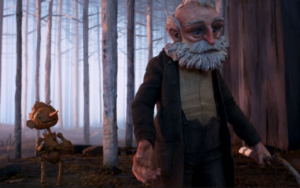GUILLERMO DEL TORO’S PINOCCHIO: 4 STARS. “brings this wooden boy to life.”
 “Pinocchio,” the wooden boy with a lie detector for a nose and dreams of becoming a real boy bouncing around his sawdusty brain, is one of the most reimagined characters in children’s literature. Earlier this year Tom Hanks starred in a traditional remake of the 138 year-old-story that echoed the classic Disney film.
“Pinocchio,” the wooden boy with a lie detector for a nose and dreams of becoming a real boy bouncing around his sawdusty brain, is one of the most reimagined characters in children’s literature. Earlier this year Tom Hanks starred in a traditional remake of the 138 year-old-story that echoed the classic Disney film.
The Oscar winning director of “The Shape of Water” takes the story in his own direction in “Guillermo Del Toro’s Pinocchio,” a stop motion retelling, now playing in theatres and coming soon to Netflix. In what may be the only version of the story featuring a cameo by Mussolini, the movie travels a different, darker path than previous adaptations.
Del Toro keeps the original story’s Italian location, but places the action between World Wars I and II. Woodworker Geppetto (voiced by David Bradley) is a skilled artisan, lovingly teaching his young son Carlo the ropes of the craft while working on large crucifix at a local church. When Carlo is killed in a bombing raid, Geppetto spirals into despair and alcoholism.
While soothing his loss with booze, the heartbroken Geppetto cuts down an Italian pine tree near his late son’s grave and builds a roughhewn puppet as a replacement for his boy. Gangly, with a long nose, the puppet sits slumped in Geppetto’s workshop until a magical Wood Sprite (voice of Tilda Swinton) breathes life into him and appoints Sebastian J. Cricket (voice of Ewan McGregor), a mustachioed insect who lives inside the puppet, as his guide and conscience.
The rowdy newborn, dubbed Pinocchio (voice of Gregory Mann), doesn’t make a great first impression on Geppetto or the local townsfolk. But as Geppetto warms to him, the locals, including fascist government official Podestà (Ron Perlman), don’t quite know what to make of him.
“Everybody likes him,” says Pinocchio, pointing to the still under construction crucifix. “He’s made of wood too. Why do they like him and not me?”
As Pinocchio tries to figure out his place in the world, he soon discovers that not everyone has his best interests in mind.
This is not your parent’s “Pinocchio.” Del Toro sticks to the bones of author Carlo Collodi’s original plot, but expands the story with a deep dive into what it means to be human, mortality, the weight of expectation and the horrors of fascism. It doesn’t sound particularly family friendly, but while there are some intense, nightmarish images, this is a fairy tale in the Brothers Grimm tradition. It speaks to the issues surrounding growing up, whether you’re made of wood or flesh and blood, and should be fine for kids ten and up.
Visually spectacular, the stop motion animation gives the movie a more organic feel than it may have had if rendered in computer generated images. Rich in detail and imagination, the film’s style mixes and matches dreams with nightmares to create a palette that paints the fanciful and the earthbound in equal measure.
“Guillermo Del Toro’s Pinocchio” does something remarkable. Just as the Wood Sprite breathed new life into Geppetto’s puppet, Del Toro breathes new life into a very familiar and often-told story. He is buoyed by fine voice work and visuals, but it is the auteur’s allegorical stamp that really brings this wooden boy to life.
